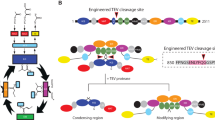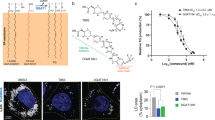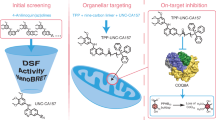Abstract
Human fatty acid synthase (hFAS) is a complex, multifunctional enzyme that is solely responsible for the de novo synthesis of long chain fatty acids. hFAS is highly expressed in a number of cancers, with low expression observed in most normal tissues. Although normal tissues tend to obtain fatty acids from the diet, tumor tissues rely on de novo fatty acid synthesis, making hFAS an attractive metabolic target for the treatment of cancer. We describe here the identification of GSK2194069, a potent and specific inhibitor of the β-ketoacyl reductase (KR) activity of hFAS; the characterization of its enzymatic and cellular mechanism of action; and its inhibition of human tumor cell growth. We also present the design of a new protein construct suitable for crystallography, which resulted in what is to our knowledge the first co-crystal structure of the human KR domain and includes a bound inhibitor.
This is a preview of subscription content, access via your institution
Access options
Subscribe to this journal
Receive 12 print issues and online access
$259.00 per year
only $21.58 per issue
Buy this article
- Purchase on SpringerLink
- Instant access to full article PDF
Prices may be subject to local taxes which are calculated during checkout




Similar content being viewed by others
References
Menendez, J.A. & Lupu, R. Fatty acid synthase and the lipogenic phenotype in cancer pathogenesis. Nat. Rev. Cancer 7, 763–777 (2007).
Maier, T., Jenni, S. & Ban, N. Architecture of mammalian fatty acid synthase at 4.5 Å resolution. Science 311, 1258–1262 (2006).
Chirala, S.S. & Wakil, S.J. Structure and function of animal fatty acid synthase. Lipids 39, 1045–1053 (2004).
Asturias, F.J. et al. Structure and molecular organization of mammalian fatty acid synthase. Nat. Struct. Mol. Biol. 12, 225–232 (2005).
Hiltunen, J.K. et al. Mitochondrial fatty acid synthesis type II: more than just fatty acids. J. Biol. Chem. 284, 9011–9015 (2009).
Jenni, S. et al. Structure of fungal fatty acid synthase and implications for iterative substrate shuttling. Science 316, 254–261 (2007).
Weiss, L. et al. Fatty-acid biosynthesis in man, a pathway of minor importance. Purification, optimal assay conditions, and organ distribution of fatty-acid synthase. Biol. Chem. Hoppe Seyler 367, 905–912 (1986).
Kuhajda, F.P. et al. Fatty acid synthesis: a potential selective target for antineoplastic therapy. Proc. Natl. Acad. Sci. USA 91, 6379–6383 (1994).
McGarry, J.D. & Brown, N.F. The mitochondrial carnitine palmitoyltransferase system. From concept to molecular analysis. Eur. J. Biochem. 244, 1–14 (1997).
Wang, Y., Kuhajda, F.P., Sokoll, L.J. & Chan, D.W. Two-site ELISA for the quantitative determination of fatty acid synthase. Clin. Chim. Acta 304, 107–115 (2001).
Flavin, R., Peluso, S., Nguyen, P.L. & Loda, M. Fatty acid synthase as a potential therapeutic target in cancer. Future Oncol. 6, 551–562 (2010).
Kuhajda, F.P. Fatty acid synthase and cancer: new application of an old pathway. Cancer Res. 66, 5977–5980 (2006).
Vázquez, M.J. et al. Discovery of GSK837149A, an inhibitor of human fatty acid synthase targeting the β-ketoacyl reductase reaction. FEBS J. 275, 1556–1567 (2008).
Turrado, C. et al. New synthetic inhibitors of fatty acid synthase with anticancer activity. J. Med. Chem. 55, 5013–5023 (2012).
Kley, J.T., Mack, J., Hamilton, B., Scheuerer, S. & Redemann, N. Discovery of BI 99179, a potent and selective inhibitor of type I fatty acid synthase with central exposure. Bioorg. Med. Chem. Lett. 21, 5924–5927 (2011).
Oslob, J.D. et al. Imidazopyridine-based fatty acid synthase inhibitors that show anti-HCV activity and in vivo target modulation. ACS Med. Chem. Lett. 4, 113–117 (2013).
Meanwell, N.A. Improving drug candidates by design: a focus on physicochemical properties as a means of improving compound disposition and safety. Chem. Res. Toxicol. 24, 1420–1456 (2011).
Hallman, J. et al. Benzimidazoles as fatty acid synthase inhibitors. World Intellectual Property Organization WO2011056635 (2011).
Chaudhari, A.M., Hallman, J., Laudeman, C., Musso, D.L. & Parrish, C.A. Azabenzimidazoles as fatty acid synthase inhibitors. World Intellectual Property Organization WO2011066211 (2011).
Adams, N.D. et al. Triazolones as fatty acid synthase inhibitors. World Intellectual Property Organization WO2011103546 (2011).
Adams, N.D. et al. Fatty acid synthase inhibitors. World Intellectual Property Organization WO2012037299 (2012).
Aquino, C.J., Heyer, D., Kiesow, T.J., Musso, D.L. & Parrish, C.A. Fatty acid synthase inhibitors. World Intellectual Property Organization WO2012037298 (2012).
Adams, N.D., Reif, A.J. & Wiggall, K. Pyrimidinone derivatives as fatty acid synthase inhibitors. World Intellectual Property Organization WO2012096928 (2012).
Joshi, A.K., Witkowski, A. & Smith, S. Mapping of functional interactions between domains of the animal fatty acid synthase by mutant complementation in vitro. Biochemistry 36, 2316–2322 (1997).
Dodds, P.F., Guzman, M.G.F., Chalberg, S.C., Anderson, G.J. & Kumarj, S. Acetoacetyl-CoA reductase activity of lactating bovine mammary fatty acid synthase. J. Biol. Chem. 256, 6282–6290 (1981).
Carlisle-Moore, L., Gordon, C.R., Machutta, C.A., Miller, W.T. & Tong, P.J. Substrate recognition by the human fatty-acid synthase. J. Biol. Chem. 280, 42612–42618 (2005).
Dutler, H. et al. Fatty acid synthetase from pig liver 2. Characterization of the enzyme complex with oxidoreductase activity for alicyclic ketones as a fatty acid synthetase. Eur. J. Biochem. 22, 213–217 (1971).
Cook, P.F. & Cleland, W.W. Enzyme Kinetics and Mechanism (Garland Science, New York, 2007).
Yonetani, T. & Theorell, H. Studies on liver alcohol dehydrogenase complexes. 3. Multiple inhibition kinetics in the presence of two competitive inhibitors. Arch. Biochem. Biophys. 106, 243–251 (1964).
Orita, H. et al. Selective inhibition of fatty acid synthase for lung cancer treatment. Clin. Cancer Res. 13, 7139–7145 (2007).
Pizer, E.S., Wood, F.D., Paternack, G.R. & Kuhajda, F.P. Fatty acid synthase (FAS): a target for cytotoxic antimetabolites in HL60 promyelocytic leukemia cells. Cancer Res. 56, 745–751 (1996).
Swinnen, J.V. et al. Fatty acid synthase drives the synthesis of phospholipids partitioning into detergent-resistant membrane microdomains. Biochem. Biophys. Res. Commun. 302, 898–903 (2003).
Henneberry, A.L., Wright, M.M. & McMaster, C.R. The major sites of cellular phospholipid synthesis and molecular determinants of fatty acid and lipid head group specificity. Mol. Biol. Cell 13, 3148–3161 (2002).
Maier, T., Leibundgut, M. & Ban, N. The crystal structure of a mammalian fatty acid synthase. Science 321, 1315–1322 (2008).
Denney, J.W. Stabilization of working reagent solutions containing NADH, NADPH, and/or enzymes, and the use of such stabilized reagents in enzyme or substrate assays. European Patent Office EP0009222 (1980).
Anderson, V.E. & Hammes, G.G. Stereochemistry of the reactions catalyzed by chicken liver fatty acid synthase. Biochemistry 23, 2088–2094 (1984).
Katiyar, S.S., Cleland, W.W. & Porter, J.W. Fatty acid synthetase: a steady state kinetic analysis of the reaction catalyzed by the enzyme from pigeon liver. J. Biol. Chem. 250, 2709–2717 (1975).
Cleland, W.W. Derivation of rate equations for multisite ping-pong mechanisms with ping-pong reactions at one or more sites. J. Biol. Chem. 248, 8353–8355 (1973).
Cairns, R.A., Harris, I.S. & Mak, T.W. Regulation of cancer cell metabolism. Nat. Rev. Cancer 11, 85–95 (2011).
Price, A.C., Zhang, Y.M., Rock, C.O. & White, S.M. Cofactor-induced conformational rearrangements establish a catalytically competent active site and a proton relay conduit in FabG. Structure 12, 417–428 (2004).
Gao, L. et al. Simultaneous quantification of malonyl-CoA and several other short-chain acyl-CoAs in animal tissues by ion-pairing reversed-phase HPLC/MS. J. Chromatogr. B Analyt. Technol. Biomed. Life Sci. 853, 303–313 (2007).
Otwinowski, Z. & Minor, W. Processing of X-ray diffraction data collected in oscillation mode. Methods Enzymol. 276, 307–326 (1997).
McCoy, A.J. et al. Phaser crystallographic software. J. Appl. Crystallogr. 40, 658–674 (2007).
Winn, M.D., Murshudov, G.N. & Papiz, M.Z. Macromolecular TLS refinement in REFMAC at moderate resolutions. Methods Enzymol. 374, 300–321 (2003).
Winn, M.D. et al. Overview of the CCP4 suite and current developments. Acta Crystallogr. D Biol. Crystallogr. 67, 235–242 (2011).
Emsley, P., Lohkamp, B., Scott, W.G. & Cowtan, K. Features and development of Coot. Acta Crystallogr. D Biol. Crystallogr. 66, 486–501 (2010).
Acknowledgements
We are grateful to C. Aquino for designing and first preparing GSK2194069 and to A. Chaudhari, J. Mack and K. Erhard for preparing additional quantities. We thank Y. Shen for construct engineering, J. Christie for virus generation and G. Barrett for large-scale cell culture. We thank B. Rodríguez, M. Jesús Vázquez and R. Liu for the high-throughput screening data; K. McKenzie and J. Gross for the initial FAS inhibition data for GSK2194069; and G. Waitt for the LC/MS/MS analyses in the M-CoA experiments. We also thank G. Graczyk-Millbrandt and M. Wang for final structure confirmation by NMR. Support of this program by R. Wooster is gratefully acknowledged. Use of the Advanced Photon Source was supported by the US Department of Energy, Office of Science, Office of Basic Energy Sciences, under contract no. DE-AC02-06CH11357. Use of the Life Sciences Collaborative Access Team (LS-CAT) Sector 21 was supported by the Michigan Economic Development Corporation and the Michigan Technology Tri-Corridor (grant no. 085P1000817).
Author information
Authors and Affiliations
Contributions
M.L.M., S.P.W. and K.K.B. designed constructs. L.W. performed and interpreted crystallization studies. S.P.W. solved and analyzed structures. W.A.B. coordinated cell preparation and purified all of the proteins. A.R.R. and R.D.T. performed biochemical mechanism studies. J.A.K. performed and analyzed western blotting and performed M-CoA experiments. R.N.P. performed and analyzed cellular growth assays and prepared cells for NMR analysis. J.B. performed and analyzed NMR studies. C.A.P. selected 2. A.R.R., G.Z., R.D.T. and M.A.H. designed experiments. A.R.R., G.Z., R.D.T., M.L.M., C.A.P. and M.A.H. interpreted and/or analyzed data. A.R.R., S.P.W., M.L.M., M.A.H. and C.A.P. wrote the paper, which was reviewed by all of the authors.
Corresponding author
Ethics declarations
Competing interests
All of the authors are employees of GlaxoSmithKline, and all are or have been shareholders of GlaxoSmithKline.
Supplementary information
Supplementary Text and Figures
Supplementary Results, Supplementary Tables 1–3 and Supplementary Figures 1–7. (PDF 837 kb)
Supplementary Note 1
Supplementary Note 1 (PDF 316 kb)
Supplementary Note 2
Supplementary Note 2 (PDF 243 kb)
Rights and permissions
About this article
Cite this article
Hardwicke, M., Rendina, A., Williams, S. et al. A human fatty acid synthase inhibitor binds β-ketoacyl reductase in the keto-substrate site. Nat Chem Biol 10, 774–779 (2014). https://doi.org/10.1038/nchembio.1603
Received:
Accepted:
Published:
Issue Date:
DOI: https://doi.org/10.1038/nchembio.1603
This article is cited by
-
A fast-acting lipid checkpoint in G1 prevents mitotic defects
Nature Communications (2024)
-
Atomic model for core modifying region of human fatty acid synthase in complex with Denifanstat
Nature Communications (2023)
-
CRISPR/Cas9 system in breast cancer therapy: advancement, limitations and future scope
Cancer Cell International (2022)
-
A global lipid map reveals host dependency factors conserved across SARS-CoV-2 variants
Nature Communications (2022)
-
Statin therapy inhibits fatty acid synthase via dynamic protein modifications
Nature Communications (2022)



